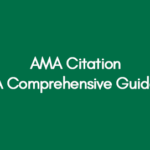
Top English Dissertation Example | Essential Tips
June 21, 2023
AMA Citation: A Comprehensive Guide to Citing Sources in AMA Style
July 13, 2023When undertaking research or writing academic papers, it is essential to acknowledge the sources you are using. Proper citation and referencing demonstrate your credibility as a researcher in your dissertation or research paper and allow readers to locate the original material you have referenced. One widely recognized referencing style is the Vancouver referencing style. The Vancouver referencing style is widely used in the medical and scientific fields for citing sources accurately.
Also, review the following link;
How to Harvard Referencing Dissertation?
How to Write Dissertation References?
This concise overview aims to provide you with a clear understanding of Vancouver referencing and practical examples to help them navigate the complexities of academic writing effectively.
What is Vancouver Referencing?
Vancouver referencing is a numeric citation style that commonly uses in the fields of medicine and science. It was developed by the International Committee of Medical Journal Editors (ICMJE) and is primarily used to cite sources within biomedical research articles.
Why is Vancouver Referencing Important?
Vancouver referencing serves several purposes. Firstly, it allows readers to identify and retrieve the sources. Secondly, it provides a standardized format for citations and references, ensuring consistency and accuracy in academic writing. And in the end, it acknowledges the intellectual property of others and gives credit to the original authors.
Basic Principles of Vancouver Referencing
It is also important to follow the right citation pattern when writing any academic paper or dissertation. For example, citation in Wikipedia refers to the practice of citing other sources in a scholarly work. It is essential to acknowledge the sources to avoid plagiarism and to provide evidence for the points being made.
1. In-Text Citations
In Vancouver referencing, in-text citations are indicated by superscript numbers within the main text. These numbers correspond to the full citation in the reference list.
For example, referencing a book, you would place a superscript number at the relevant point in your text^1^. The superscript number should appear after the punctuation mark.
2. Reference List
The reference list in Vancouver style provides complete bibliographic information for each cited source. The references are listed numerically in the order they appear in the text. Each reference starts with a superscript number, followed by the necessary details of the source.
How to Cite Different Types of Sources in Vancouver Style?
These are some examples and practices of Vancouver style citing for different sources;
Books
To cite a book in Vancouver style, the following elements are required:
- Author(s) or editor(s)
- Book title
- Edition (if applicable)
- Place of publication
- Publisher
- Year of publication
- Page numbers (if applicable)
Example:
- Smith J. Introduction to Biomedical Research. 3rd ed. New York: ABC Publishing; 2022. p. 25-30.
Journal Articles
For citing journal articles in Vancouver style, include the following information:
- Author(s)
- Article title
- Journal title (abbreviated according to the Index Medicus/MEDLINE)
- Year of publication
- Volume(issue) number
- Page numbers
Example:
- Johnson A, Brown R, Davis M. The Impact of Vaccination on Public Health. J Med Res. 2023;10(2):45-52.
Websites
Citing websites in Vancouver style requires the following details:
- Author(s) (if available)
- Page title (or website title)
- URL
- Date of access (if the content is likely to change)
Example:
- World Health Organization. Immunization and Vaccines [Internet]. Available from: https://www.who.int/immunization/en/. Accessed June 1, 2023.
Reports
To cite a report in Vancouver style, include the following information:
- Author(s)
- Report title
- Place of publication
- Publisher
- Year of publication
- Page numbers (if applicable)
Example:
- National Institutes of Health. Global Health Report 2022. Washington, D.C.: NIH Publications; 2022.
Common Challenges for Vancouver Referencing and How to Overcome Them
While Vancouver referencing may seem straightforward, it can present challenges for students and researchers. Some common challenges include:
- Accurate formatting of citations and references.
- Determining the correct abbreviation for journal titles.
- Finding all the necessary information for each source.
To overcome these challenges, it is advisable to refer to official Vancouver style guides, use citation management tools, and consult with academic institutions' guidelines.
Conclusion
In academic writing, proper referencing is crucial for acknowledging the work of others, ensuring credibility, and providing readers with the means to verify and locate the cited sources. Vancouver referencing offers a systematic approach to citation and referencing in the fields of medicine and science. By following the principles and examples provided in this article, students and researchers can effectively implement Vancouver referencing in their own dissertation writing.
Get 3+ Free Dissertation Topics within 24 hours?


























